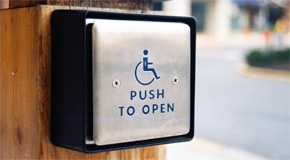 Building for accessibility
Building for accessibility

Building for accessibility is an important part of being an inclusive city.
Over 5% of Vancouver residents have some form of physical disability or mobility restriction. This includes people using wheelchairs, walkers, and canes. When you add their accompanying family and friends, approximately 50% of Vancouver residents are affected by poor access to buildings.
The accessibility of a building depends on the entrance, door widths, and door handles of the building.
Entrance ramps
Many older buildings in Vancouver are inaccessible because of just two or three stairs at the entrance. A short ramp or raised section of sidewalk can replace stairs, making the building entrance accessible.
Ramps and elevated sidewalks should be at a maximum angle of 10% and include at least one handrail. The City may consider steeper ramps, if they are short in length.
New buildings should always avoid adding stairs and include ramps at the entrance.
Door widths
The minimum door width to accommodate wheelchairs is 850 mm. Existing door widths can sometimes be increased by using swing away hinges, however some remodelling of the door frame may be required.
Door handles
Lever-operated door handles are the standard accessible door handle in North America. These door handles are easy to use with only one hand and do not require any tight grasping, or wrist twisting.
Accessible Street Design
The Accessible Street Design manual provides City standards on making streets and sidewalks accessible to all pedestrians, including people with mobility and visual impairments, and people using wheelchairs.
 Lever-operated door handles are accessible because they are easy to use with one hand?
Lever-operated door handles are accessible because they are easy to use with one hand?